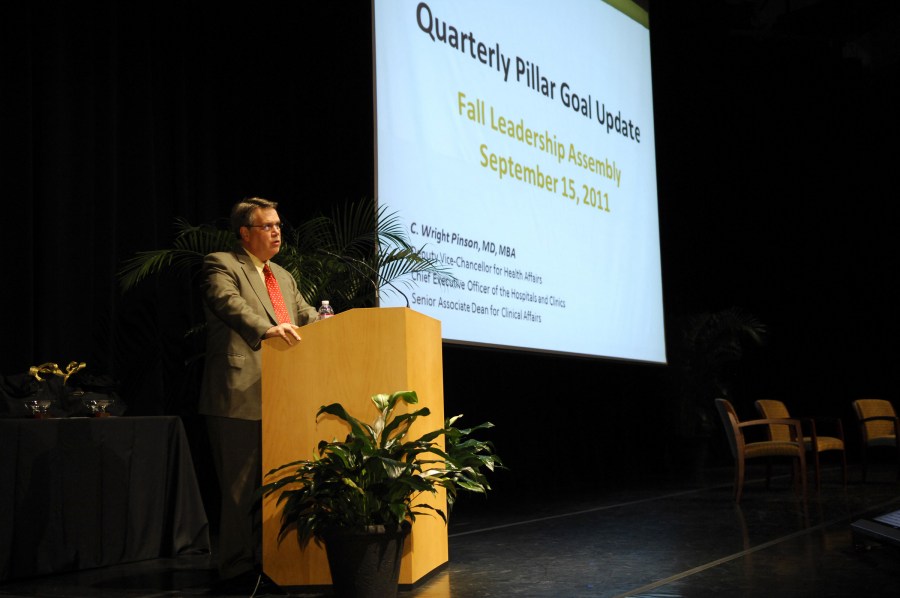
C. Wright Pinson, MBA, M.D., delivers the Five Pillars update at last week’s Clinical Enterprise Leadership Assembly in Langford Auditorium. (photo by Anne Rayner)
Employee satisfaction takes center stage at leadership meet
Employee satisfaction was identified as a yearlong Medical Center initiative at last week’s Clinical Enterprise Leadership Assembly, an event drawing about 700 managers, administrators and faculty leaders that also included the quarterly Five Pillars update.
Increased employee satisfaction leads to improved patient satisfaction, employee retention and reduced cost. This year, VUMC managers will focus on improved communication and collaboration around this common organizational goal. Progress will be measured through our employee satisfaction survey this fall, as well as through measured improvements in new employee retention and overall annual employee turnover.
This year’s goals again make for a full agenda: beyond the focus on employee satisfaction, clinical enterprise managers and their teams will seek to lower hospital length of stay; make better use of team-level patient satisfaction data; further improve hand hygiene compliance; improve upon declining hospital-acquired infection rates; increase communications with referring providers; and improve upon processes surrounding patient handovers.
Further goals include instituting routine telephone calls to check on patients following hospital discharges and clinic visits, and increased emphasis on fewer hand-written prescriptions in favor of electronically prescribing.
Jeff Balser, M.D., Ph.D., vice chancellor for Health Affairs and dean of the School of Medicine, expressed sincere appreciation for everyone’s sustained commitment and hard work in FY 2011. After disruptive February snows threatened to spoil the year’s financial performance, Vanderbilt providers committed to seeing more patients in clinics.
This effort provided a cascading effect, helping to boost both inpatient admissions and surgical volumes, allowing VUMC to end the fiscal year achieving its key financial goals.
Balser reminded the audience of the Medical Center’s goal of replenishing its days of cash on hand since the economic crash of 2009, and noted a percentage of 2011’s net revenue help rebuild VUMC’s savings. The 2011 margin revenue will also be used to make salary adjustments for certain segments of the workforce so that VUMC will remain competitive in the local labor market.
Additional revenue will be used for high priority clinical equipment replacement and renovations.
Patient satisfaction at VUMC is scored as the percent of patients rating their overall quality of care and teamwork of the health care team as excellent.
C. Wright Pinson, MBA, M.D., deputy vice chancellor for Health Affairs and CEO of the Vanderbilt Health System, announced that programs with scores greater than 73 percent during last year will try to improve by at least two percentage points this year, while programs with scores less than 73 percent for last year will try to improve by at least four percentage points.
This year’s Provider Communication Wizard target is 75 percent of total visits requiring communication. The Wizard is an electronic tool that significantly increases ease and decreases time necessary for follow-up communication with referring providers. The tool is catching on fast: by July usage had increased to 64 percent for clinic visits requiring communication back to referring providers.
Pinson said clinics will seek more efficient backfilling of any patient cancellations, which is an effective way to continue recent reductions in new-patient wait times.
And from the podium he read a glowing letter about nursing care at Vanderbilt, from the husband of a patient.
“Not only did I like receiving that letter, but it makes me very, very proud to work with each and every one of you, and makes me proud to be a member of Vanderbilt University Medical Center,” Pinson said.
He introduced new goals for reducing mortality, reducing adverse events, increasing systems reliability, increasing hand hygiene, increasing electronic prescribing and improving patient handovers. Over the past year Vanderbilt has succeeded in reducing hospital-acquired infections by an astounding 36 percent; teams will try for further reductions this year.
Pinson noted successes in diagnostic management, population-based disease prevention, clinical genetic testing, warfarin management and employee health plan cost control. All these projects will increase in scale this year and a new project will focus on reducing hospital length of stay.
Chief Human Resources Officer Traci Nordberg described how successful managers tend to reserve more time for interaction with team members, and led a brief panel discussion about how to improve these interactions.
To get the year’s focus on “employee satisfaction” under way, Nordberg suggesting review of an article published in the Harvard Business Review by Henry Mintzburg, the Bronfman professor of Management at McGill University, titled “The Manager’s Job: Folklore and Fact,” for information about behaviors of the successful manager in our dynamic work environment.
The article can be accessed through the elevate website: http://rafael.glendale.edu/ppal/Busad%20101/mintzbergmar1990.pdf.
All Leadership Assembly presentations are posted on the elevate Web site (https://www.mc.vanderbilt.edu/elevate, employee log-in required).













